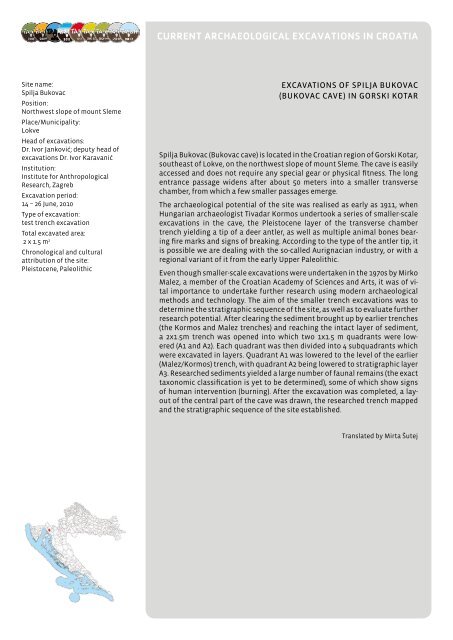AMZ_TAIUH_2017_ prijevodi na engleski
Create successful ePaper yourself
Turn your PDF publications into a flip-book with our unique Google optimized e-Paper software.
CURRENT ARCHAEOLOGICAL EXCAVATIONS IN CROATIA<br />
Site <strong>na</strong>me:<br />
Spilja Bukovac<br />
Position:<br />
Northwest slope of mount Sleme<br />
Place/Municipality:<br />
Lokve<br />
Head of excavations:<br />
Dr. Ivor Janković; deputy head of<br />
excavations Dr. Ivor Karavanić<br />
Institution:<br />
Institute for Anthropological<br />
Research, Zagreb<br />
Excavation period:<br />
14 – 26 June, 2010<br />
Type of excavation:<br />
test trench excavation<br />
Total excavated area:<br />
2 x 1.5 m 2<br />
Chronological and cultural<br />
attribution of the site:<br />
Pleistocene, Paleolithic<br />
EXCAVATIONS OF SPILJA BUKOVAC<br />
(BUKOVAC CAVE) IN GORSKI KOTAR<br />
Spilja Bukovac (Bukovac cave) is located in the Croatian region of Gorski Kotar,<br />
southeast of Lokve, on the northwest slope of mount Sleme. The cave is easily<br />
accessed and does not require any special gear or physical fitness. The long<br />
entrance passage widens after about 50 meters into a smaller transverse<br />
chamber, from which a few smaller passages emerge.<br />
The archaeological potential of the site was realised as early as 1911, when<br />
Hungarian archaeologist Tivadar Kormos undertook a series of smaller-scale<br />
excavations in the cave, the Pleistocene layer of the transverse chamber<br />
trench yielding a tip of a deer antler, as well as multiple animal bones bearing<br />
fire marks and signs of breaking. According to the type of the antler tip, it<br />
is possible we are dealing with the so-called Aurig<strong>na</strong>cian industry, or with a<br />
regio<strong>na</strong>l variant of it from the early Upper Paleolithic.<br />
Even though smaller-scale excavations were undertaken in the 1970s by Mirko<br />
Malez, a member of the Croatian Academy of Sciences and Arts, it was of vital<br />
importance to undertake further research using modern archaeological<br />
methods and technology. The aim of the smaller trench excavations was to<br />
determine the stratigraphic sequence of the site, as well as to evaluate further<br />
research potential. After clearing the sediment brought up by earlier trenches<br />
(the Kormos and Malez trenches) and reaching the intact layer of sediment,<br />
a 2x1.5m trench was opened into which two 1x1.5 m quadrants were lowered<br />
(A1 and A2). Each quadrant was then divided into 4 subquadrants which<br />
were excavated in layers. Quadrant A1 was lowered to the level of the earlier<br />
(Malez/Kormos) trench, with quadrant A2 being lowered to stratigraphic layer<br />
A3. Researched sediments yielded a large number of fau<strong>na</strong>l remains (the exact<br />
taxonomic classification is yet to be determined), some of which show signs<br />
of human intervention (burning). After the excavation was completed, a layout<br />
of the central part of the cave was drawn, the researched trench mapped<br />
and the stratigraphic sequence of the site established.<br />
Translated by Mirta Šutej


